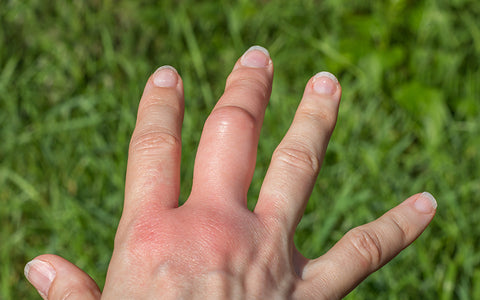What is wasp allergy?
Wasps usually sting when they feel threatened. They’re more aggressive than bees and also tend to be more attracted to your food and rubbish. So they’re a particular pest for humans. Swat a wasp eyeing up your lunch and you could get stung. And that can be a threat to anyone who’s allergic to wasp venom.
A wasp's sting is its defence mechanism. The short sharp blast is meant to make you leave the insect alone. Some pain, redness and swelling is normal afterwards. But with wasp allergy this can spread beyond the sting site and last up to a week. A severe allergic reaction to the venom can be life-threatening.
Read more about wasp allergy, the symptoms, how to treat them and when they’re most likely to happen.
When is wasp allergy season?
Wasp stings tend to happen most in late summer and autumn. That’s the riskiest time for an allergic reaction. Queen wasps emerge from hibernation to build a nest in the spring. The colony expands and peaks over the summer. There are no jobs to do in the nest after that. Instead wasps roam looking for sugary foods. You might notice them paying even more attention to your picnic.
Yellow jackets are a type of wasp too and have a similar life cycle. Scientists call their erratic late summer behaviour “delirium”. It’s why yellow jackets also tend to sting more, triggering insect sting allergy, in August and September.
Wasp allergy season comes to an end when temperatures drop and the entire colony dies.
Common wasp allergy symptoms
Allergic reactions to wasps tend to be more than 10cm across. They can make your whole arm or leg swell up, not just the sting site. You may get more swelling than is usual with an insect sting. The redness could be more pronounced too but may be harder to see on darker skin. These large local allergic reactions can last a week and are often treated in the same way as a normal sting. That is, with first aid and anti-itch creams, of which more below.

Wasp allergy: Sudden serious reactions
Insect sting allergy can cause a severe allergic reaction called anaphylaxis. It’s less likely with wasps than bee stings but it’s still important to know the common symptoms. Call an ambulance if you spot any of these signs of a severe reaction:
- Light headedness or fainting
- Fast or shallow breathing, wheezing or other trouble breathing
- Heart beating more quickly (palpitations)
- Sweaty skin
- Anxiety and disorientation
- Loss of consciousness
Anaphylactic shock is the most serious possible symptom. You may feel faint and even pass out because of a sudden drop in blood pressure. It can be life-threatening and needs immediate medical attention.
How long after being stung do wasp allergy symptoms start?
Insect sting anaphylaxis can happen suddenly, in minutes or up to a few hours after the first reaction. But other wasp allergy symptoms may not be immediate. Sometimes large local allergic reactions develop hours afterwards and go on building for one or two days. There have also been reports of delayed reactions as much as five days after multiple wasp stings, although this is rare.
Wasp allergy: the inside story
You need to be stung by a wasp at least twice to become allergic to the venom. This is due to a process called sensitisation. The first time, your immune system registers the wasp venom as a threat. It produces Immunoglobulin E (IgE) antibodies for that allergen. You’re sensitised now and may develop an allergy. Not everyone does and scientists don’t yet know why that is.
Wasp allergy is when the IgE antibodies spot the venom when you’re stung and set off allergic reactions to defend you. They trigger different cells to start the process of getting rid of the allergen from your body in various different ways. That causes your symptoms.
Allergies can develop at any age. Children may outgrow wasp allergy, except if they have a serious reaction. Then they’re more likely to have an allergic reaction later in life.
How to find out if you’ve got wasp allergy
You know what wasp allergy symptoms look like now and think you may be affected. Now it’s time to talk to your GP about getting a diagnosis. They’ll take note of your worst insect sting reaction as part of your medical history.
A description of the insect can help determine the species. However the allergenic proteins in insect venom from wasps, yellow jackets and hornets are very similar. Cross-reactions can cause symptoms from more than just your main trigger. So your GP may request allergy skin or blood tests.
|
Wasps vs bees: can you tell the difference? Wasps and honeybees can look a lot alike, especially in a moment of panic. Both collect nectar and have a similar shape. But there are important differences too: |
|
|
Wasps
|
Honeybees
|
Wasp allergy checklist: how to avoid insect stings
Wasp spray does kill them indoors but be careful not to breathe it in. Outdoors, repellents for skin and clothes don’t tend to work well on stinging insects. So here are some tips for avoiding stings during wasp allergy season.
- Smells
- Choose unscented toiletries including sunscreen and avoid sweet-smelling perfumes
- The scent of banana is especially attractive
- Clothes
- Go for neutral rather than brightly coloured clothing or flowery prints but avoid black
- Wear summer sandals with closed toes
- Cover as much skin as possible
- Food and drink
- Keep kitchen surfaces clean and put leftovers away
- Drink from a screw top bottle rather than a can and put the cap back on between sips
- Cover food outdoors
- Pick fruit as soon as it ripens in your garden and don’t leave windfalls to rot and attract wasps
- Keep calm
- Never swat a wasp as it can make them release an alarm pheromone to call other wasps to help
- Keep still if you spot a single wasp flying around
- If there are lots of them move into the shade
- Quickly open car windows to let a wasp out or pull over and open the doors

Wasp allergy treatment
An ice pack or cold compress may be all that’s needed for wasp stings, even large local reactions. But you could also try corticosteroid cream or an oral antihistamine or calamine lotion to ease your symptoms. An over-the-counter painkiller may help too. Unless the swelling is particularly painful or widespread, in which case you may need medical attention.
Because of the risk of anaphylaxis your GP is likely to prescribe an adrenaline auto-injector. The advice is to carry two of them at all times. This is emergency treatment for you to use to counteract severe reactions as they happen. Wearing a medical alert bracelet will tell people you’re allergic to insect stings so they know how to help you. You will also need an ambulance.
Specialist treatments for insect allergy
Specialist treatments may be able to help retrain your immune system so that it reacts differently. The treatment is called allergy immunotherapy and it involves regular tiny doses of your particular allergen. A full course takes three to five years and it can reduce the risk of severe insect allergy symptoms.
Specialist treatment may be right for you if you’ve had a severe reaction previously. Your GP or allergist will assess and advise you.



